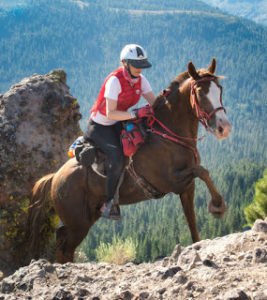by Sharon Choney, Cargill Equine Consultant.
Performance horses in all disciplines, from racing to western pleasure, are expected to deliver optimum performance all year around, regardless of temperature. Allowing the horse to deliver optimum performance in the summer under conditions of high temperature and humidity presents several challenges to the horse owner. Proper management of working conditions, water consumption and feeding practices can help meet the challenge.
First, avoid working the horses during the warmest part of the day when possible. Early morning and evening rides are better for both horse and rider. Horses confined during the day should have shade, ventilation and fresh clean water. This applies to horses in stalls, at shows or in the pasture. If horses must be trained or shown during the heat of the day, they should be offered water regularly. A hot horse must not be allowed to drink large quantities of cold water then stand but a horse cannot cool down properly if it is dehydrated. The rule “six sips and walk” provides a good guideline. Horses going in classes throughout the day must be allowed to drink regularly, as dehydration and heat stroke can be deadly. Loss of fluid can also make a horse prone to colic. If a horse stops sweating, immediate action is required.
Second, feeding management practices can be adjusted, particularly the energy sources fed. The horse’s total thermal load can be reduced by using highly digestible fiber sources and added fat feed sources. High fiber hay produces more heat increment or heat of digestion than lower fiber hay. Fat produces the lowest heat increment. The most heat efficient hay source for a performance horse would be an early cut grass or grass legume mixture. This hay should be fine in texture and relatively soft to the touch. An added fat feed or the addition of corn oil to the diet will provide higher energy with lower intake, and will assist in reducing the thermal load. Added fat diets may also produce the additional performance benefits of increased endurance and reduced fluid loss. Feeding small amounts throughout the day rather than two large feedings may also be beneficial as the heat produced by digestion can be spread out. Very high levels of protein should be avoided as the excess nitrogen increases fluid loss due to the higher urine output.
Third, loose trace mineral salt in a feeder protected from rain should be available free choice. Manufactured feeds will generally contain 0.5%-1.0% salt, but a performance horse may require 4-6 ounces of salt per day to maintain electrolyte balance. Horses will generally not consume this much block salt. Electrolyte supplements may be beneficial immediately before and during a competition, but care must be exercised to make certain the horse is consuming adequate water. Giving a concentrated electrolyte without adequate water consumption may actually increase the potential for a problem.
Summer is a great season to spend more time with horses. Proper management can help make certain it is pleasant and safe for both horse and rider.
Contact Sharon Choney for information on Nutrena products for horses:
direct: 760-625-9441
email: Sharon_choney@cargill.com
For more information please go to Nutrenaworld.com and prognutrition.com
Feature Photo credit: susan-twh-tevis-cup.jpg
[The Equine Report adds:] The featured photo was taken during the Tevis Cup, a 100-mile, 24-hour endurance race over the Sierra Nevada. The race takes place on a weekend in July or August that is closest to a full moon. Temperatures in the canyons along the Tevis route can reach triple digits, making the Tevis probably the hardest test of a horse in summer. There are mandatory stops along the way, where horses can eat, drink, and get bathed and iced down. Veterinarians on duty will not release a horse to continue the race until his vitals return to normal and he can trot sound. The Haggin Cup is awarded to the horse in the best condition among the top 10 finishers of the Tevis route.





